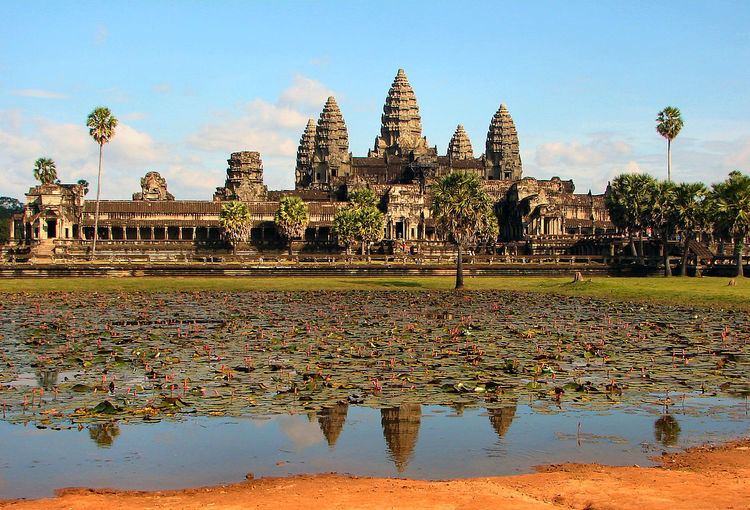 | ||
The UNESCO (United Nations Educational, Scientific and Cultural Organization) has designated 37 World Heritage Sites in eleven countries (also called "State parties") of Southeast Asia: Indonesia, Vietnam, Thailand, Philippines, Malaysia, Myanmar, Cambodia, Singapore, and Laos. Only Brunei and East Timor lack World Heritage sites.
Contents
- Legend
- Location of sites
- UNESCO Tentative List of Southeast Asia
- UNESCO Intangible Cultural Heritage Register of Southeast Asia
- Southeast Asia Memories of the World Register
- UNESCO Biosphere Reserves of Southeast Asia
- References
Indonesia and Vietnam lead the list with eight inscribed sites each, with the Philippines having six, Thailand five, Malaysia four, Cambodia and Laos two each, and Myanmar and Singapore one each. The first sites from the region were inscribed at the 15th session of the World Heritage Committee in 1991. The latest site inscribed is the Singapore Botanic Gardens in Singapore inscribed in 39th session of the Committee in Bonn, Germany in July 2015. Each year, UNESCO's World Heritage Committee may inscribe new sites or delist those no longer meeting the criteria, the selection based on ten criteria of which six stand for cultural heritage (i–vi) and four for natural heritage (vii–x); some sites are "mixed" and represent both types of heritage. In Southeast Asia, there are 23 cultural, 13 natural and 1 mixed sites.
The World Heritage Committee may also specify that a site is endangered, citing "conditions which threaten the very characteristics for which a property was inscribed on the World Heritage List." One site in this region, Tropical Rainforest Heritage of Sumatra, is listed as endangered; Angkor and Rice Terraces of the Philippine Cordilleras were once listed but were taken off in 2004 and 2012 respectively.
Legend
The table is sortable by column by clicking on the at the top of the appropriate column; alphanumerically for the Site, Area, and Year columns; by state party for the Location column; and by criteria type for the Criteria column. Transborder sites sort at the bottom.
Site; named after the World Heritage Committee's official designation Location; at city, regional, or provincial level and geocoordinates Criteria; as defined by the World Heritage Committee Area; in hectares and acres. If available, the size of the buffer zone has been noted as well. A value of zero implies that no data has been published by UNESCO Year; during which the site was inscribed to the World Heritage List Description; brief information about the site, including reasons for qualifying as an endangered site, if applicable.Location of sites
Green - Natural; Yellow - Cultural; Blue - Mixed; Red - Endangered
UNESCO Tentative List of Southeast Asia
Brunei, Singapore, and East Timor have currently no tentative sites listed in UNESCO. Malaysia, Myanmar, and Vietnam revised their tentative lists in 2014, while Indonesia, the Philippines, and Thailand revised theirs in 2015. Cambodia and Laos last revised their tentative lists in 1992.
UNESCO Intangible Cultural Heritage Register of Southeast Asia
The Intangible Cultural Heritage of Southeast Asia is represented by Cambodia, Indonesia, Malaysia, the Philippines, and Vietnam. Myanmar, Thailand, Laos, Singapore, Brunei, and East Timor have either not yet submitted an intangible heritage to UNESCO or they have yet to ratify and participate in the Intangible Cultural Registrar of UNESCO. Southeast Asia has two endangered intangible cultural heritage, Ca trung singing of Vietnam and Noken multifunctional knotted or woven bag, handcraft of the people of Papua of Indonesia. The latest inscription for Southeast Asia is Tugging rituals and games in 2015, which is composed of submissions by Cambodia, the Philippines, South Korea, and Vietnam.
Southeast Asia Memories of the World Register
UNESCO's Memory of the World Programme is an international initiative launched to safeguard the documentary heritage of humanity against collective amnesia, neglect, the ravages of time and climatic conditions, and willful and deliberate destruction.[1] It calls for the preservation of valuable archival holdings, library collections and private individual compendia all over the world for posterity, the reconstitution of dispersed or displaced documentary heritage, and the increased accessibility to and dissemination of these items.
Southeast Asia's entry to the Memories of the World Register was through the submission of the Philippine Paleographs (Hanunoo, Build, Tagbanua and Pala’wan) by the National Museum of the Philippines in 1999, where it was inscripted on the same year as well. Following this landmark for the region, Malaysia followed with an immediate three submissions in 2001, all of which were inscripted the same year. Vietnam, Thailand, and Indonesia followed in 2003. After these landmark submissions and inscriptions, Southeast Asia's contribution to the Memories of the World Register has expanded into 24, 1 from Cambodia, 5 from Indonesia (1 of which is a multinational inscription), 4 from Malaysia, 3 from Myanmar (1 of which is a multinational site), 4 from the Philippines, 4 from Thailand, 1 from Timor-Leste, and 2 from Vietnam. Singapore, Laos, and Brunei have yet to inscript a submission in the Register.
UNESCO Biosphere Reserves of Southeast Asia
Launched in 1971, UNESCO’s Man and the Biosphere Programme (MAB) is an Intergovernmental Scientific Programme that aims to establish a scientific basis for the improvement of relationships between people and their environments.
MAB combines the natural and social sciences, economics and education to improve human livelihoods and the equitable sharing of benefits, and to safeguard natural and managed ecosystems, thus promoting innovative approaches to economic development that are socially and culturally appropriate, and environmentally sustainable.
Its World Network of Biosphere Reserves currently counts more than 650 biosphere reserves in at least 120 countries all over the world. Southeast Asia is currently represented by 29 Biosphere Reserves; 1 from Cambodia, 10 from Indonesia, 2 from Malaysia, 1 from Myanmar, 2 from the Philippines, 4 from Thailand, and 9 from Vietnam. Brunei, Laos, Timor-Leste, and Singapore currently has no inscribed biosphere reserves in the list.
